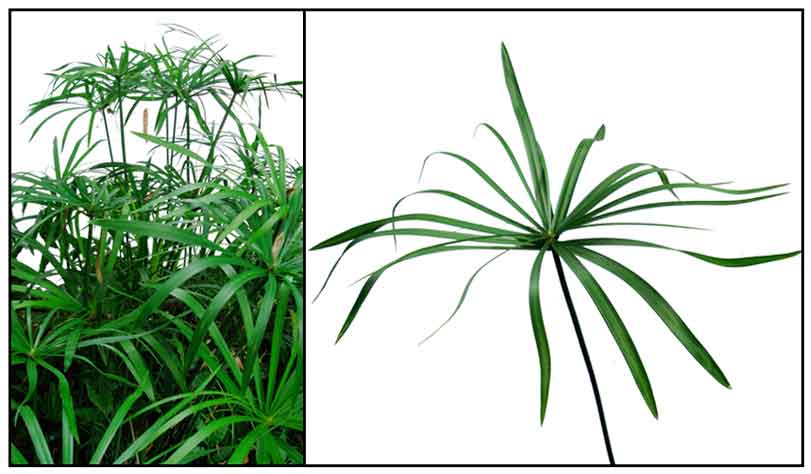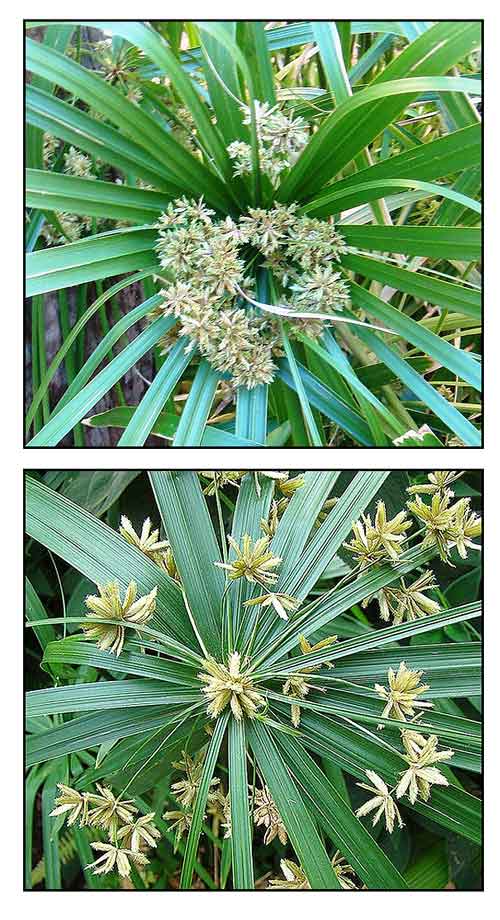
General info
- Cyperus alternifolius, the umbrella papyrus, umbrella sedge, or umbrella palm, is a grass-like plant in the large genus Cyperus of the sedge family Cyperaceae. It is widely distributed worldwide.
- It has gained the Royal
Horticultural Society's Award of Garden Merit. (12)
- Etymology:
The genus name Cyperus derives from Greek word kupeiros meaning "sedge", while the species epithet alternifolius means "alternate-leaved."
Botany
• Cyperus alternifolius is a clustering perennial growing to a height of 1.5 meters. Stems are cylindric, ribbed, smooth and green. Leaves are linear, radiating from the terminal point of stem, spreading or slightly drooping, up to 20 centimeters long. Flowers are small, green and clustered.
• Cyperus alternifolius is a perennial semi-aquatic erect herb, up to 2 m tall, with fibrous roots and a rhizome. Stem is somewhat 3-angled, solid, and glabrous. At the base, there are 4 to 5 very short leaves, almost reduced to sheaths. At the top is an umbrella-like arrangement of up to 30 linear blades about 30 cm long ; they are hairless, with parallel veins, a slender tip and a scabrous edge. Inflorescenceis a large umbel of 10 to 20 rays bearing at their extremity small groups of flattened, greenish brown spikelets. (13)
 Distribution Distribution
- Introduced into the Philippines; naturalized.
-
Widely distributed in the Philippines, in canals, ponds, and riversides.
- Occasionally planted as an ornamental.
- Native to Angola, Benin, Botswana, Burundi, Cameroon, Cape Provinces, Chad, Congo, Djibouti, Eritrea, Ethiopia, Ghana, Guinea, Kenya, KwaZulu-Natal, Liberia, Madagascar, Malawi, Mauritania, Mozambique, Nigeria, Rwanda, Saudi Arabia, Senegal, Sierra Leone, Somalia, Sudan, Tanzania, Uganda, Yemen, Zambia, Zaïre, Zimbabwe. (2)
Constituents
- Study of hydrodistilled volatile oil of flowers yielded 40 compounds representing about 98% of the oil. Sesquiterpenes constituted the bulk of the oil (ca. 62%); major components were α-cyperone 19.6%, ß-selinene 9.8%, caryophyllene oxide 7.2%, and cyperene 5.2%. (see study below) (4)
- Phytochemical screening of total alcoholic extract
and successive extracts yielded eight phenolic compounds viz., esculetin (1), umbelliferon (2), imperatorin (3), psoralen (4), xanthotoxin (5), quercetin (6), quercetin-3-O-rutinoside (7) and gallic acid (8). (see study below) (8)
- GC-MS analysis of tubers and aerial parts for essential oil identified 17 and 15 volatile compounds representing 99.16% and 100% of total mass, respectively. Terpenes (97.82% and 97.43% were more characteristic content including sesquiterpenes (97.22 and 3.89%) and monoterpenes (0.6 and93.54%), respectively. Tubers EO yielded caryophyllene (50.6%), caryophyllene oxide (29.84%), farnesyl acetone (4.65%) as major components. Aerial parts EO yielded major components of D-limonene (63.78%), theaspirane A (13.36%), theaspirane B (10.97%), and γ-terpinene (3.4%). (see study below) (14)
Properties
- Studies have suggested antibacterial, antifungal, antioxidant, phytoremediative, hepatoprotective, antiulcer properties.
Parts
utilized
Leaves, roots
Uses
Folkloric
• No reported folkloric medicinal use in the Philippines.
Studies
• Antifungal / Antioxidant / Antibacterial:
Study of root and leaf extracts of Cyperus alternifolius showed moderate activity against all yeast tested, while the root extract showed a clear antioxidant activity. It showed strong activity against both sensitive and resistant S aureus strains and against E faecalis. (1)
• Municipal Wastewater Treatment / Comparative Efficiency:
Study compared the efficiency of Cyperus alternifolius and Phragmites australis in municipal wastewater treatment by Subsurface Constructed Wetland Method. Results showed C. alternifolius plant had higher efficiency in the removal of chemical parameters, while P. australis had efficiency in the removal of microbiological parameters. (3)
• Essential Oil / Flowers / Antioxidant: Study of hydro-distilled volatile oil of flowers of Cyperus alternifolius yielded 40 compounds. Evaluation by DPPH free radical assay showed the volatile oil to have significant antioxidant activity. (see constituents above) (4)
• Removal of Pollutant Sludge: Study evaluated the ability of Cyperus alternifolius to remove pollutant in sludge through constructed wetland. Results showed that in general CA can treat industrial sludge with high efficiency with a potential for high economic efficiency. (5)
• Phytoremediative in Heavy Metal Pollution / Cr and Ni Combined Pollution: Study evaluated the ability of C. alternifolius in restoring water with combined heavy metal pollution. Results showed Cyperus alternifolius had tolerance and enrichment ability to Cr (VI) and Ni, and can be used to restore Cr (VI) polluted water and Cr (VI)-Ni combined polluted water under low Ni concentrations. (6)
• Floating Phytoremediation System: A greenhouse study showed Cyperus alternifolius and Coleus blumei could grow well in a floating phytoremediation system with good effects on the removal of pollutants in the floating phytoremediation system. (7)
• Hepatoprotective / Carbon Tetrachloride Toxicity: Study evaluated the potential hepatoprotective activity of total ethanol and successive extracts of C. alternifolius against CCl4-induced hepatotoxicity in rats. Results showed significant (p≤0.05) protective effect as evidenced by lowering chemical parameters. (see constituents above) (8)
• Phytoremediation of Levonorgestrel in Aquatic Environment: Study evaluated the absorption and degradation of levonorgestrel (LNG) by two hydrophytes, Cyperus alternifolius and Eichhornia crassipes. Phytoremediation of water polluted by LNG was found to be feasible; both CA and EC could accelerate the removal of LNG and shorten LNG exposure in the aquatic environment. (9)
• Antiulcer / Mechanistic Study: Study evaluated for safer antiulcer therapies based on methanol and ethyl acetate extracts of tubers and aerial parts of C. alternifolius on gastric ulceration induced by single oral doses of indomethacin to fasted rats. The extracts significantly reduced ulcer number, total ulcer score, TNF-α content in the stomach. ME and EAE of tubers were most effective, more than ranitidine. The mechanism of action was postulated based on reported actions viz. α-carbohic anhydrase inhibition, anti-inflammatory, and analgesic activity by its antioxidant activity and downregulation of several inflammatory mediators. (10)
• Chromium Removal Capacity / Photosynthetic Characteristics: Study evaluated the chromium removal capability and phtosynthetic capacity response of plants in vertical flow wetland microcosms (VFWM). Two plants, Cyperus alternifolius and Coix lachryma-jobi enhanced the purification of Cr(VI) enriched domestic sewage. Results showed that a VFWM with C. alternifolius and/or C. lachryma-jobi were capable of maintaining efficiency and recovering its vegetation. The VFWM was promising for purifying wastewater which contains low to medium concentration of Cr(VI) (<20 mgL). (11)
• Radical Scavenging Activity / Essential Oils / Tubers and Aerial Parts: GC-MS analysis of tubers and aerial parts for essential oil identified 17 and 15 volatile compounds representing 99.16% and 100% of total mass, respectively. The aerial parts oil showed significant antioxidant activity at all concentrations in relation to rutin. The EO of tubers exhibited moderate antioxidant activity at 5 µg/mL and 10 µg/mL with values of 1.33 and 1.12, respectively. Significant antioxidant activity was exhibited by aerial parts at three concentrations of 2.5, 5, and 10 µg/mL with activity values of 5.83, 7.18, and 8.48, respectively. (see constituents above) (14)
• Phytoremediative / Plant Uptake of Diclofenac: Study evaluated the uptake of diclofenac, a widely used nonsteroidal anti-inflammatory pharmaceutical, by macrophyte C. alternifolius in a mesocosm-scale free water surface (FWS) constructed wetland. The FWS with C. alternifolius showed a maximum 69.3% diclofenac removal efficiency, compared to control without plant with removal efficacy of 2.7% at end of 70-day test period. Diclofenac translocation potentially from root to stem was <0.5, suggesting a slow and passive translocation process of diclofenac. Results suggest high potential for C. alternifolius for phytoremediation of diclofenac in FWS and application in other engineered ecosystems. (15)
Availability
Wild-crafted. |

![]()

